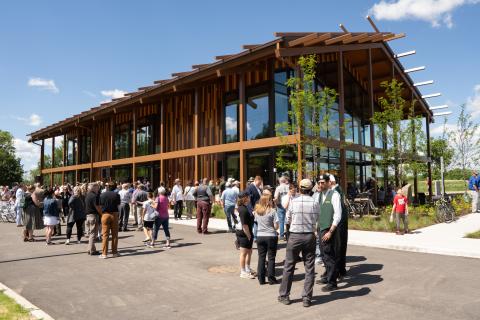New podcast explores indigenous history of 'The Ohio Country'

Listen to this Episode
A new podcast from Ohio Newsroom member station WYSO explores the history of the Ohio tribes that were removed from the Ohio River Valley. The creators of The Ohio Country traveled around Ohio and Oklahoma to catch up to those tribes and tell the story of how they're reconnecting with the region.
Neenah Ellis co-created the podcast with Chris Welter and she joined the Ohio Newsroom to talk about the project.
This interview has been lightly edited for brevity and clarity.
The history of indigenous tribes in the Ohio River Valley stretches over thousands of years. So how did you choose what to highlight as you set out to tell this story?
"The pressing question for us was: What happened to the tribes and how was it that the tribes came to be removed by the United States government? And in order to answer that question, you have to go back hundreds of years.
Because you have to explain how the tribes were living here before white Europeans came. Then you have to explain what happened when the white culture came to North America. Then you have the American Revolution. Then any number of conflicts after that. So we had to walk through that whole history in order to get us to the mid-1800s, roughly 1830, when the tribes were removed by the United States. So that was kind of the lens through which we wanted to focus our questions.
We think we have a unique angle here and that is to try to tell this story through an indigenous lens. This story has been told for hundreds of years from a white perspective, from an American government perspective. But when you start to look at this same story, this same set of facts through an indigenous lens, you see a completely different story. So we worked with indigenous scholars from around the Midwest and Oklahoma to hear the story in a different way.
And we think it gets us a little closer to this more inclusive Ohio history."
One of the experts you talked to was Talon Silverhorn of the Eastern Shawnee tribe. He put it this way: "When it comes to history, in my opinion, there's a lot more to be learned from the realities of history than what we portray and invent about history."
So how did you see that tension between myth and reality play out as you started to dig into this history?
"Well, there's a lot of myth. And honestly, I have to say, I didn't even know it was myth until I started to scratch at it.
One myth is that the Ohio River Valley was a pristine wilderness before the settlers came. That's not true. This was a region that had been inhabited for thousands of years and this landscape was very carefully managed with ecological approaches by the tribes. So when white settlers came here and they saw, "Wow, look at these beautiful prairies, look at these wide open spaces," they didn't know what they were totally looking at. These are spaces that had been managed with, among other things, fire.
Another kind of mythology puts these white heroes in the center of the story, people like Daniel Boone and Simon Kenton, that they were big saviors and conquered the wilderness. And that is a mythology that puts way too much focus to those people.
Another one that is a tragic myth — and you hear it in literature, it's even in the U.S. constitution — is that the tribal people were savages who did not understand the land that they were living on, that they didn't understand what could be done with this land. And to say those words out loud is just horrible. But it was a predominant myth."
Talon Silverhorn, who we heard from earlier, was instrumental in creating the newly opened Great Council State Park, which aims in part to tell the story of native people in Ohio. How else are tribal citizens telling history in a new way and reconnecting with the land here?
"There are other examples of tribal citizens being more actively engaged in historic interpretation at historic sites. Talon does that at different places around Ohio, for example at Hale Farm, which is run by the Western Reserve Historical Society. They invited him to come and do a demonstration there of traditional Shawnee maple sugar methods. This kind of approach is sadly rather new in Ohio, where actual tribal citizens tell the story and meet with the public and answer questions.
There's a new exhibit at Fort Recovery that was collaboratively created with a group of indigenous women scholars and Ball State University and the Ohio History Connection to retell the story of the defeat of Arthur St. Clair by the nine confederated tribes in the late 1700s.
So there are many new collaborations going on, new approaches to storytelling. The state of Ohio is dedicated to working collaboratively with tribal citizens to tell stories. So we're going to be hearing more and more about this kind of collaborative effort but we're a little behind many other states who have indigenous tribes; tribal governments based there are way ahead of us in this regard. But there is an effort being made and it is happening here in Ohio."
9(MDYwODMwNTczMDE2ODk5NTExNDAyNzM5Ng000))
- Home
- Schedules
- TV
- TV
- Local TV Programs
- Business | Life 360 with Kristi K.
- Toledo Stories
- To The Point with Doni Miller
- Listening with Keith Burris
- Ideas & Insights
- WGTE Presents
- BL360: Northwest Ohio Innovation Consortium
- Magic of the Old West End
- Freedom Means Never Surrender
- I&I: The Random Factor
- FF: National Cherry Festival
- TTP: Moms Demand Action For Gun Sense in America
- Watch Live
- Radio
- Education
- Community
- Support
- About
- Donate
- Watch Live


